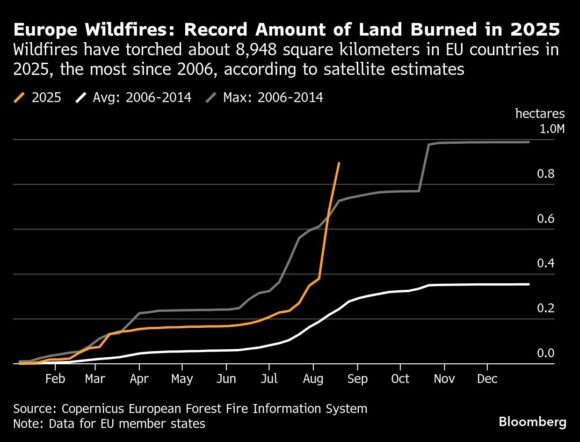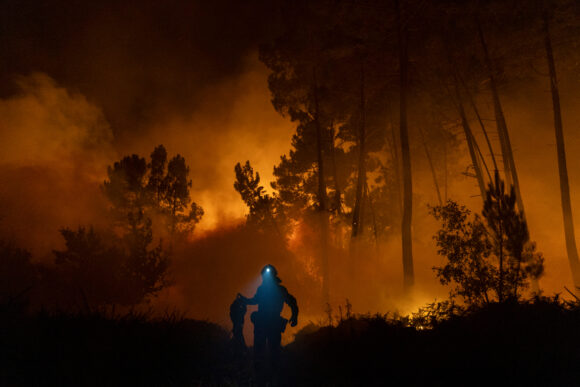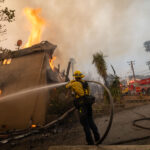Four major heat waves, dry conditions and strong winds have turned Europe into a tinderbox this summer, fueling the most destructive wildfire season in nearly two decades.
Blazes have scorched about 8,948 square kilometers (3,455 square miles) across the European Union in 2025 — more land than in any year since 2006, according to new satellite estimates from the Copernicus space program.
Fire activity has surged in recent weeks as another blast of unseasonable heat sapped the last moisture from Europe’s fields and forests, leaving them primed to ignite. Deadly, wind-whipped blazes have flared from Portugal and Spain to Greece and Albania. Researchers say climate change is making Europe’s summers hotter, drier and more dangerous — and the continent is warming faster than any other in the world.

Though the latest wave is easing, fire crews in Spain are still battling some 40 active blazes. More than 31,000 people have been forced to evacuate in recent days, with flames consuming 3,482 square kilometers (1,344 square miles) of land this year — the most since 2006, satellite estimates show. During investigations into the causes of various fires, Spain’s civil guard and national police have arrested 31 people, according to data from the Ministry of the Interior.
Prime Minister Pedro Sanchez is set to visit the provinces of Caceres and Zamora, where officials say the emergency has triggered the largest wave of international firefighting assistance in Spain’s history. Planes and personnel are arriving from as far away as Finland and Slovakia.
Cooler weather is forecast in Spain, breaking a 16-day heat wave that’s likely the country’s third-longest in more than three decades, according to government forecaster AEMET. But despite the colder air, half the country still faces extremely dangerous fire conditions.
In neighboring Portugal, temperatures are also set to drop, though most of the north, center and the Algarve region remain on the highest alert. Four major blazes are still active. One in the Trancoso area has raged for more than a week and is on track to be the largest wildfire ever recorded in the country. Another is still spreading; almost 1,500 firefighters are currently deployed to stop it.
Prime Minister Luis Montenegro, who has urged calm and national unity, pledged support for devastated regions but has yet to visit the hard-hit north. “We are at war and we must win this war,” he said Monday at a press briefing near Lisbon. So far, fires have scorched 2,162 square kilometers (835 square miles) — Portugal’s worst year since 2006.
The blazes are a hot-button issue. Montenegro canceled his summer holidays only after attending a party rally in the Algarve, a move that drew rebuke from across the political spectrum. Critics have also seized on his delay in activating the EU Civil Protection Mechanism, while far-right leader Andre Ventura has gone further, calling for the resignation of Interior Minister Maria Lucia Amaral.
Wildfires are a political sensitivity in Portugal, especially post-2017, when more than 100 people died in the country’s deadliest blazes. Many were trapped in cars after receiving conflicting evacuation advice. In the wake of the disaster, the then-interior minister resigned. Some of this year’s worst fires are again burning in those same scarred areas.
Photograph: A member of the Emergency Military Unit works to extinguish a wildfire next to a village in Pepín, in Ourense province, Spain, on Aug. 19, 2025; photo credit: Pablo Blazquez Dominguez/Getty Images
Related:
- Update: Deadly Fires Rage in Greece and Spain as Heat Blasts Cyprus
- Wildfire Briefly Shut Dardanelles Strait to Shipping as Europe Battles Infernos
Was this article valuable?
Here are more articles you may enjoy.



 Catastrophe Bonds Linked to Wildfires Lose ‘Untouchable’ Status
Catastrophe Bonds Linked to Wildfires Lose ‘Untouchable’ Status  CEO Sentenced in Miami to 15 Years in One of the Largest Health Care Fraud Cases
CEO Sentenced in Miami to 15 Years in One of the Largest Health Care Fraud Cases  Court Ruling Could Help Shed Light on Owners of Litigation Funders, Medical Clinics
Court Ruling Could Help Shed Light on Owners of Litigation Funders, Medical Clinics  Viewpoint: Artificial Intelligence Is Rewriting the Rules for Commercial Lines
Viewpoint: Artificial Intelligence Is Rewriting the Rules for Commercial Lines 

